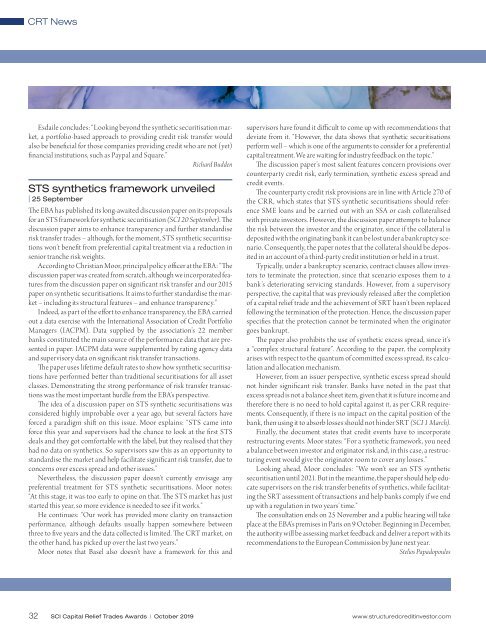SCI CRT Awards Issue Oct 19
Create successful ePaper yourself
Turn your PDF publications into a flip-book with our unique Google optimized e-Paper software.
<strong>CRT</strong> News<br />
Esdaile concludes: “Looking beyond the synthetic securitisation market,<br />
a portfolio-based approach to providing credit risk transfer would<br />
also be beneficial for those companies providing credit who are not (yet)<br />
financial institutions, such as Paypal and Square.”<br />
Richard Budden<br />
STS synthetics framework unveiled<br />
| 25 September<br />
The EBA has published its long-awaited discussion paper on its proposals<br />
for an STS framework for synthetic securitisation (<strong>SCI</strong> 20 September). The<br />
discussion paper aims to enhance transparency and further standardise<br />
risk transfer trades – although, for the moment, STS synthetic securitisations<br />
won’t benefit from preferential capital treatment via a reduction in<br />
senior tranche risk weights.<br />
According to Christian Moor, principal policy officer at the EBA: “The<br />
discussion paper was created from scratch, although we incorporated features<br />
from the discussion paper on significant risk transfer and our 2015<br />
paper on synthetic securitisations. It aims to further standardise the market<br />
– including its structural features – and enhance transparency.”<br />
Indeed, as part of the effort to enhance transparency, the EBA carried<br />
out a data exercise with the International Association of Credit Portfolio<br />
Managers (IACPM). Data supplied by the association’s 22 member<br />
banks constituted the main source of the performance data that are presented<br />
in paper. IACPM data were supplemented by rating agency data<br />
and supervisory data on significant risk transfer transactions.<br />
The paper uses lifetime default rates to show how synthetic securitisations<br />
have performed better than traditional securitisations for all asset<br />
classes. Demonstrating the strong performance of risk transfer transactions<br />
was the most important hurdle from the EBA’s perspective.<br />
The idea of a discussion paper on STS synthetic securitisations was<br />
considered highly improbable over a year ago, but several factors have<br />
forced a paradigm shift on this issue. Moor explains: “STS came into<br />
force this year and supervisors had the chance to look at the first STS<br />
deals and they got comfortable with the label, but they realised that they<br />
had no data on synthetics. So supervisors saw this as an opportunity to<br />
standardise the market and help facilitate significant risk transfer, due to<br />
concerns over excess spread and other issues.”<br />
Nevertheless, the discussion paper doesn’t currently envisage any<br />
preferential treatment for STS synthetic securitisations. Moor notes:<br />
“At this stage, it was too early to opine on that. The STS market has just<br />
started this year, so more evidence is needed to see if it works.”<br />
He continues: “Our work has provided more clarity on transaction<br />
performance, although defaults usually happen somewhere between<br />
three to five years and the data collected is limited. The <strong>CRT</strong> market, on<br />
the other hand, has picked up over the last two years.”<br />
Moor notes that Basel also doesn’t have a framework for this and<br />
supervisors have found it difficult to come up with recommendations that<br />
deviate from it. “However, the data shows that synthetic securitisations<br />
perform well – which is one of the arguments to consider for a preferential<br />
capital treatment. We are waiting for industry feedback on the topic.”<br />
The discussion paper’s most salient features concern provisions over<br />
counterparty credit risk, early termination, synthetic excess spread and<br />
credit events.<br />
The counterparty credit risk provisions are in line with Article 270 of<br />
the CRR, which states that STS synthetic securitisations should reference<br />
SME loans and be carried out with an SSA or cash collateralised<br />
with private investors. However, the discussion paper attempts to balance<br />
the risk between the investor and the originator, since if the collateral is<br />
deposited with the originating bank it can be lost under a bankruptcy scenario.<br />
Consequently, the paper notes that the collateral should be deposited<br />
in an account of a third-party credit institution or held in a trust.<br />
Typically, under a bankruptcy scenario, contract clauses allow investors<br />
to terminate the protection, since that scenario exposes them to a<br />
bank’s deteriorating servicing standards. However, from a supervisory<br />
perspective, the capital that was previously released after the completion<br />
of a capital relief trade and the achievement of SRT hasn’t been replaced<br />
following the termination of the protection. Hence, the discussion paper<br />
specifies that the protection cannot be terminated when the originator<br />
goes bankrupt.<br />
The paper also prohibits the use of synthetic excess spread, since it’s<br />
a “complex structural feature”. According to the paper, the complexity<br />
arises with respect to the quantum of committed excess spread, its calculation<br />
and allocation mechanism.<br />
However, from an issuer perspective, synthetic excess spread should<br />
not hinder significant risk transfer. Banks have noted in the past that<br />
excess spread is not a balance sheet item, given that it is future income and<br />
therefore there is no need to hold capital against it, as per CRR requirements.<br />
Consequently, if there is no impact on the capital position of the<br />
bank, then using it to absorb losses should not hinder SRT (<strong>SCI</strong> 1 March).<br />
Finally, the document states that credit events have to incorporate<br />
restructuring events. Moor states: “For a synthetic framework, you need<br />
a balance between investor and originator risk and, in this case, a restructuring<br />
event would give the originator room to cover any losses.”<br />
Looking ahead, Moor concludes: “We won’t see an STS synthetic<br />
securitisation until 2021. But in the meantime, the paper should help educate<br />
supervisors on the risk transfer benefits of synthetics, while facilitating<br />
the SRT assessment of transactions and help banks comply if we end<br />
up with a regulation in two years’ time.”<br />
The consultation ends on 25 November and a public hearing will take<br />
place at the EBA’s premises in Paris on 9 <strong>Oct</strong>ober. Beginning in December,<br />
the authority will be assessing market feedback and deliver a report with its<br />
recommendations to the European Commission by June next year.<br />
Stelios Papadopoulos<br />
32 <strong>SCI</strong> Capital Relief Trades <strong>Awards</strong> | <strong>Oct</strong>ober 20<strong>19</strong> www.structuredcreditinvestor.com




